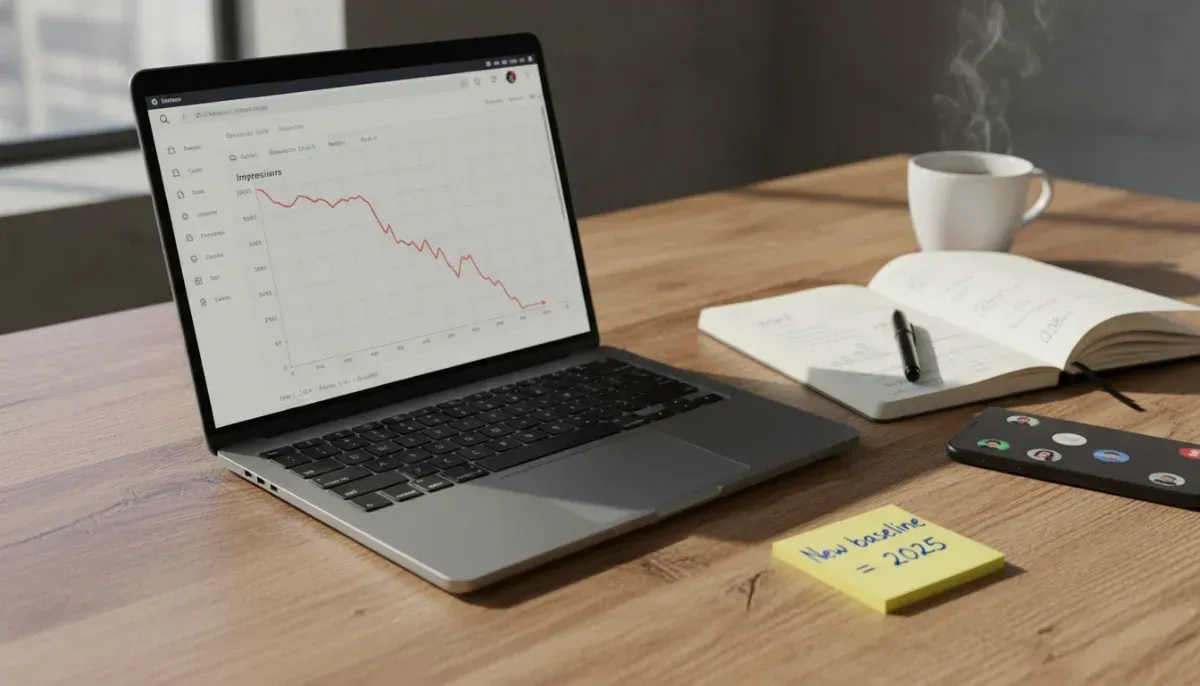
Why Your Google Impressions Dropped (And Why That’s Actually Good News)
If you’ve been staring at your Google Search Console dashboard lately, you’ve probably noticed something unsettling: your impressions have tanked. And I mean really tanked.
You’re not alone. In fact, 87.7% of websites experienced a significant drop in reported impressions in 2025. But here’s the thing, this isn’t the disaster it looks like on the surface.
Let me walk you through what actually happened, why it happened, and most importantly, what you should do about it.
The Data: Understanding the Impressions Collapse
In early 2025, Google made a quiet but significant change to how Search Console reports data. They removed the “&num=100” parameter, a technical setting that had allowed third-party tools to fetch up to 100 search results per query.
What does that mean ??? For years, automated crawlers and bots were inflating your impression numbers by treating these tool-based queries as legitimate user searches. When Google removed this parameter, those artificial impressions disappeared.
The result? A sudden, dramatic drop in reported impressions across the board. But here’s the critical insight: your actual website traffic didn’t drop. The data just got cleaner.
The Story: What This Means for Your Marketing Strategy
I get it. Seeing those numbers plummet is anxiety-inducing. Your boss asks questions. Your stakeholders worry. Your confidence in your SEO strategy wavers.
But let’s reframe this: Google just handed you more accurate data. Instead of chasing vanity metrics inflated by bot traffic, you’re now looking at real user behaviour. Real searches. Real intent.
Here’s what else happened alongside the impressions drop: average positions improved. Why? Because the removal of bot-generated noise meant your rankings were being measured against actual competition, not artificial search volume.
Think of it like this: You were running a race where 30% of the competitors were holograms. Now they’re gone. Your position relative to real competitors just got better.

The Insights: What You Should Actually Care About
So what does this mean for your marketing strategy? Three key insights:
Your baseline is now accurate. Stop comparing your current impressions to last year’s inflated numbers. Use this as your new baseline for measuring growth.
Quality over quantity matters more than ever. With cleaner data, you can now focus on attracting high-intent users rather than chasing impression volume.
Your CTR might look different. Since impressions are lower but clicks remain relatively stable, your click-through rate may appear higher, which is actually a positive signal.
The Action: What to Do Right Now
Alright, enough context. Here’s your action plan:
1. Update Your Reporting Framework
Stop using last year’s impression numbers as your benchmark. Create a new baseline starting from when the change occurred (early 2025). This gives you an apples-to-apples comparison going forward.
2. Focus on Click-Through Rate (CTR) and Conversions
Impressions are now a less reliable metric. Instead, track:
CTR trends (are more people clicking your results?)
Conversion rates (are those clicks turning into customers?)
Average position (are you ranking higher for your target keywords?)
3. Audit Your High-Performing Keywords
Look at keywords where your position improved despite lower impressions. These are your real winners—the searches where you’re genuinely competitive. Double down on content around these topics.
4. Communicate This to Stakeholders
Don’t let the impressions drop become a crisis narrative. Proactively explain to your team and leadership what happened. Share this insight: “We now have cleaner, more accurate data that better reflects real user behaviour.” Frame it as a positive step toward better decision-making.
The Bottom Line
Your Google impressions didn’t drop because your SEO strategy failed. They dropped because Google cleaned up its data. Your actual visibility to real users? That’s likely improved or stayed stable.
This is a moment to recalibrate, not panic. Use this cleaner data to make smarter marketing decisions. Focus on quality metrics that actually drive business results. And remember: the best marketing strategy is built on accurate data, not inflated vanity metrics.
What’s Your Next Move?
Have you noticed the impressions drop in your Search Console? How are you planning to adjust your reporting and strategy? Share your thoughts in the comments below—I’d love to hear how you’re navigating this change.
And if you need help auditing your keyword performance or rebuilding your SEO strategy around these new metrics, let’s talk.
Sources & Further Reading:
Cemoh - Google Impressions Drop Analysis: https://www.cemoh.com
Search Engine Land - Latest SEO News: https://searchengineland.com
Google Search Console Updates: https://developers.google.com/search/blog/2025/06/search-console-insights?hl=en



